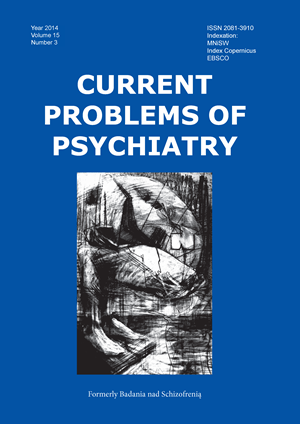Właściwości psychometryczne Kwestionariuszado Badania Uzależnienia od Gier Internetowych (KBUGI)
Słowa kluczowe:
kwestionariusz, uzależnienie od gier internetowychAbstrakt
W artykule opisano właściwości psychometryczne Kwestionariusza do Badania Uzależnienia od Gier Internetowych KBUGI. Pierwotną wersją KBUGI, składająca się ze 130 itemów przebadano grupę 576 młodzieży w wieku od 16 do 19 roku życia, mieszkającą na terenie województwa lubelskiego. Na postawie analizy czynnikowej wyodrębniono cztery czynniki (skale): (1) Strata, (2) Rozrywka i poszukiwanie nowych bodźców, (3) Kompensacja i ucieczka, (4) Przemoc i dominacja. Odrzucono itemy o najniższych ładunkach czynnikowych oraz o najniższych wskaźnikach swoistości czynnikowej. Wyodrębnione czynniki wyjaśniają w sumie 54% wariancji. Ostateczna wersja kwestionariusza KBUGI składa się z 74 pytań. Współczynniki rzetelności dla poszczególnych czynników są wysokie i wynoszą: dla czynnika - Strata alfa Cronbacha = 0,98; dla czynnika - Rozrywka i poszukiwanie nowych bodźców alfa Cronbacha = 0,93, dla czynnika - Kompensacja i ucieczka alfa Cronbacha = 0,89, dla czynnika - Przemoc i dominacja alfa Cronbacha=0,83. Współczynnik rzetelności dla wyni-ku ogólnego KBUGI wynosi 0,97. Kwestionariusz KBUGI stanowi rzetelne, posiadające dobre właściwości psychometryczne narzędzie, służące do badania różnych wymiarów uzależnienia od gier internetowych.
Bibliografia
przedszkolnym. Curr. Probl. Psychiatry, 2010: 11(4): 375-379.
2. Johansson A., Götestam K.G. Problems with Computer Games without Monetary Reward: Similarity to Pathological Gambling. Psychol. Rep., 2005; 95(2); 641–650.
3. Gentile D.A. Pathological Video Game Use Among Youth Ages 8 to 18: a National Study. Psychol. Sci., 2009; 20(5): 594-602.
4. Rehbein F., Kleimann M., Mediasci G., Mossle T. Prevalence and Risk Factors of Video Game Dependency in Adolescence: Results of a German Nationwide Survey. Cyberpsychol. Behav. Soc. Netw., 2010; 13(3): 269–277.
5. Müller K.W., Janikian M., Dreier M., Wölfling K., Beutel M.E., Tzavara C., Richardson C., Tsitsika A. Regular gaming behavior and internet gaming disorder in European adolescents: results
from a cross-national representative survey of prevalence, pre-dictors, and psychopathological correlates. Eur. Child Adolesc. Psychiatry, 2014; DOI 10.1007/s00787-014-0611-2.
6. American Psychiatric Association. Diagnostic and statistical manual of mental disorders (5th ed.). Arlington, VA: American Psychiatric Publishing; 2013.
7. Kim E.J., Namkoong K., Ku T., Kim S.J. The relationship between online game addiction and aggression, self-control and narcissis-tic personality traits. Eur. Psychiatry, 2008; 23(3): 212-218.
8. Ng B.D., Wiemer-Hastings P. Addiction to the Internet and online gaming. Cyberpsychol. Behav., 2005; 8(2): 110-113.
9. Ryan R.M., Rigby C.S., Przybylski A. The Motivational Pull of Video Games: A Self-Determination Theory Approach. Motiv. Emot., 2006; 30(4): 347-363.
10. Wan C.S., Chiou W.B. The motivations of adolescents who are addicted to online games: A cognitive perspective. Adolescence, 2007; 42(165): 179-197.
11. Wan C.S., Chiou W.B. Why are adolescents addicted to online gaming? An interview study in Taiwan. Cyberpsychol. Behav., 2006; 9(6): 762-766.
12. Hellström C., Nilsson K.W., Leppert J., Ĺslund C. Influences of motives to play and time spent gaming on the negative conse-quences of adolescent online computer gaming. Comp. Hum. Behav., 2012; 28(4): 1379-1387.
13. Kneer J., Glock, S. Escaping in digital games: The relationship between playing motives and addictive tendencies in males. Comp. Hum. Behav., 2013; 29(4): 1415-1420.
14. Horzum M.B. Examining computer game addiction level of prima-ry school students in terms of different variables. Educ. Sci., 2011; 36(159): 56-68.
15. Chiu S., Lee J.Z., Huang D.H. Video game addiction in children and teenagers in Taiwan. Cyberpsychol. Behav., 2004: 7(5): 571-581.
16. Fang X., Zhao F. Personality and enjoyment of computer game play. Computers in Industry,2010; 61(4): 342-349.
17. Slater M.D., Henry K.L., Swaim R.C., Anderson L.L. Violent media content and aggressiveness in adolescents: A downward spiral model. Comm. Res., 2003; 30: 713-736.
18. Przybylski A., Ryan R.M., Rigby C.S. The motivating role of violence in video games. Pers. Soc. Psychol. Bull., 2009; 35(2), 243-259.


